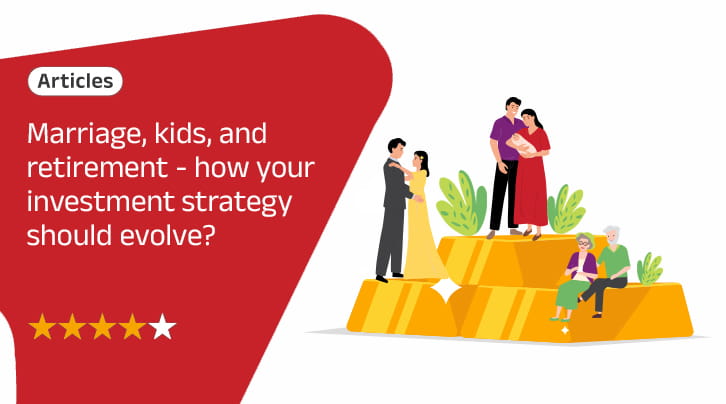-
Our Products
Our FundsFocus Funds
-
Self Care
Self-ServiceFind InformationWays To TransactPartner Solutions
-
Downloads
- Learnings
- About Us
-
More
-
Shareholders
-
Shareholders
-
Updates
-
-
SIP Calculators
- Back
-
Shareholders
Marriage, kids, and retirement - how your investment strategy should evolve?

Mar 31, 2025
5 min
4 Rating
Do you remember your childhood? Those carefree days when nothing seemed to weigh you down? As we grow older, those moments become distant memories, replaced by the responsibilities that shape our adult lives. Whether it is the responsibility of managing your own education or being accountable for your family’s well-being, life demands more as you move through its different stages.
With responsibilities, come worries. And one of the most significant of those worries is financial. Planning your financial goals early is critical to achieving a balanced and secure life. As life’s circumstances evolve, so should your financial planning—especially your investment strategy.
Evolving Goals & Changing Strategies
A key element to successful investing is adaptability. A well-timed strategy can help you make the most of your opportunities, whether you are at the start of your career, raising a family, or nearing retirement.
As a famous quote goes: "The only constant in life is change." And as your personal milestones shift, so will your financial priorities. Investors can be conservative, aggressive, or somewhere in between. For most people, their risk appetite varies at different life stages, and it is important to adapt your investment strategy to suit your current needs and future goals.
Let us look at how three key milestones—marriage, children, and retirement—can shape your investment strategy.
1. Marriage: The Early Years of Independence and Adventure
In the early stages of adulthood, especially when newly married, financial priorities often centre around enjoying life and building a foundation for future goals. With fewer responsibilities and dependents, you may be more willing to take risks, focusing on short-term goals like traveling and making memories while beginning to think about long-term planning.
For those in this stage, equity mutual funds are an excellent option. These funds focus on investing in stocks and have the potential for higher returns , albeit with higher risk. Since you have time on your side, you can afford to take a more aggressive stance.
Example mutual funds for this stage:
Large-Cap Equity Funds: These invest in well-established companies, offering higher returns with moderate risk.
Mid-Cap and Small-Cap Funds: These funds invest in medium to small-sized companies, which have a higher growth potential but also come with greater risk.
Sectoral Funds: These focus on specific sectors (e.g., technology, healthcare), offering higher returns if the sector performs well, though they are more volatile.
2. Kids: Shifting Focus to Family and Security
As you move into your 30s or 40s, your priorities start to shift with the arrival of children and growing family responsibilities. Suddenly, your financial goals become more long-term and stable. You are no longer solely thinking about your adventures or luxuries, but about securing your family’s future—child education, emergency savings, and even planning for unforeseen medical expenses.
At this stage, your risk tolerance starts to decline as you have more to lose. Investments need to be more balanced, with a mix of riskier growth opportunities and more stable, income-generating options to ensure the safety of your family's financial security.
For this phase, balanced mutual funds work well.
Example mutual funds for this stage:
Balanced or Hybrid Funds: These funds invest in both equities and bonds, offering a mix of growth potential and safety. They are ideal for investors who want to balance risk and return.
Children’s Education Funds: These funds are often tailored to saving for a child's education and can be a mix of equity and debt-based investments to suit the time horizon.
Equity Funds for longer term goals: Investors here can still opt for equity funds for their long term financial goals- large cap funds which provide some degree of stability can be preferred
3. Retirement: Shifting towards Stability and Preservation
As retirement approaches, typically in your 50s or 60s, your investment strategy needs to become even more conservative. The focus now is on preserving the wealth you have built, while continuing to generate enough income to support your post-retirement lifestyle. The risk appetite is at its lowest here—your investments should be more focused on income generation and stability, rather than aggressive growth.
At this stage, it is crucial to move towards debt funds and target-maturity funds that provide lower risk and consistent returns, reducing the impact of market fluctuations.
Example mutual funds for this stage:
Debt Funds: These funds invest in fixed-income securities like bonds and provide lower risk with relatively stable returns, ideal for those nearing retirement.
Target Maturity Funds: These are debt-based funds with a defined maturity date and pre-determined returns. They invest primarily in fixed-income securities like bonds, providing greater predictability and certainty.
Retirement Funds: These funds are specifically designed to meet retirement goals and can include a mix of equity and debt to ensure growth while minimizing risk as you approach retirement.
Options like Systematic Transfer Plans (STPs) and Systematic Withdrawal Plans (SWPs) become more attractive. These strategies allow you to shift your investments gradually from equity to debt, which is less volatile and more predictable.
Growing up means leaving childhood behind, but not the essence of being carefree. Just like a well-built parachute lets a skydiver enjoy the fall without fear, thoughtful financial planning gives us the confidence to embrace life without constant worry.
By revisiting and revising your investment strategy to match your life stage, you can move from one milestone to the next with confidence, knowing that your financial future is well-planned.
Mutual Fund investments are subject to market risks, read all scheme related documents carefully.





 1800-270-7000
1800-270-7000



